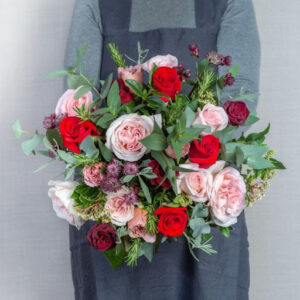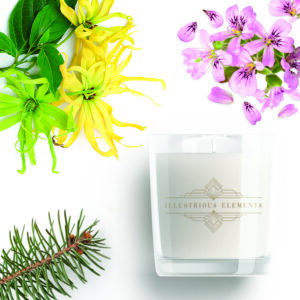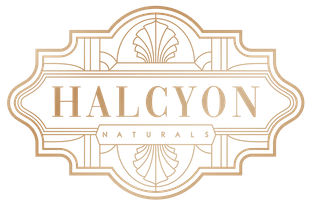You should be showing Mother Earth love this Valentine’s Day and flowers aren’t the way to do it…
When you think of Valentine’s Day, you’ll no doubt picture bouquets of red roses and vases full of blooms.
Bunches of peonies and classic carnations find themselves bundled and gifted to prove our affections and celebrate the day, but as much as we adore this centuries-long tradition, there’s a darker side to our stems.
Flowers have been an integral part of showing appreciation to our loved ones for years, we can bet that they’ve brought you plenty of joy in the past! But with the holiday just around the corner, we want to show you how you can gift something to your Valentine without causing havoc on our fragile environment.
Because after all, we’re all about showing we care sustainably here at Halcyon Naturals. Mother Earth deserves to be our Valentine, too!

Roses are red…
If you search for the birth of flower giving, you’ll find sources that cite the 17th, 18th and 19th Centuries as the catalyst. And while it may not be 100% clear when our love for the fleur began, it’s widely noted that roses in particular were the favourite flower of the Roman Goddess of Love herself, Venus.
(Speaking of Venus, we’ve got something *very* exciting coming your way at the end of the month… more on this below!)
Fast forward to 2027, and the global flower industry is estimated to be worth an eye-watering $43.8 billion. And to date, the UK, Netherlands, USA and Japan make up almost half of the worldwide trade.
Within that, around 110 million Valentine’s roses are sold in the UK alone in the run-up to V Day.
Why are cut flowers bad for the environment?
We don’t want to wilt your spirits and ruin your love for cut flowers, but we know you’re a conscious consumer that’s looking for sustainable choices.
Chemicals and pesticides increase greenhouse gases
As with any mass-produced product, there are other costs at stake.
In order to grow flowers on a commercial scale, more often than not, harmful chemicals and pesticides are used to increase production and reduce damage from local pests. But this also wipes out the planet-loving species too, vital pollinators like bees.
These harmful chemicals and toxins seep into the soil, damage the delicate ecosystem, enter our air and absorb into our drinking water systems.
Although there are rules and regulations against the use of deadly chemicals for crop production, the flower industry bypasses them because flowers aren’t an edible crop, meaning many huge scale farms can use them without penalty.
Using these pesticides releases gasses into the atmosphere, adding to the catastrophic effects of climate change by upping the (already) scary ozone pollution statistics.
As well as the chemicals used, there’s an enormous amount of water irrigation that’s needed to keep them growing, too.

Travel uses heaps of energy resources
The global production of cut flowers has moved to warmer climes in recent years, to Colombia, Ecuador, Kenya and Ethiopia, to take advantage of better growing conditions and lower labour costs.
But if you’re buying your blooms from a commercial farm on the other side of the world, they’ll need to get to you in a fresh state. Rotten, wilted flowers don’t give off the best impression to your Valentine!
If you’ve ever picked a flower yourself, you’ll no doubt have noticed how quickly its beauty begins to fade. So how do these commercial giants manage to keep them fresh?
Fridges. Huge, temperature-controlled fridges. That’s in both the storage on the farm and in the planes and trucks used to ship the stems to your door.
It’s said that refrigerated trucks can use up to 25% more energy than their warmer cousins, which in turn means that they emit 25% more emissions during delivery.
This is yet another example of overconsumption ruining something beautiful, but there is a way around it
We know this information might leave you feeling frustrated, after all, we know you love to keep your environmental impact as low as possible (and treat your beloved!).
So, here are some alternate options that show you care, without the harm:
Flowers from The Real Flower Company.
 If you’re not ready to give up the blooms completely, then look for producers as local to you as possible.
If you’re not ready to give up the blooms completely, then look for producers as local to you as possible.
London based The Real Flower Company have a gorgeous selection of bouquets that have been hand-arranged by their expert florists, with sustainability at the centre.
They only store their blooms for a maximum of 2 days (instead of 2 weeks or more for commercial farms) to reduce their energy usage, and only cut what they know they will sell so no stem goes to waste.
Plus, they keep beehives, ladybird houses and guinea foul among their farms to encourage natural pollination and keep pests at bay, and never use toxic chemicals.
Gift a Halcyon Naturals scent
For us, we believe there’s no better gift than aromachology. Not only are all of our candles, room mists and diffusers cruelty-free, vegan and completely recyclable, but they are also packed with powerful, natural essential oils to help your SO feel oh-so-loved.
Our Valentine’s picks:
Love Candle (of course!), featuring ylang ylang and patchouli, both known for their aphrodisiac and libido-increasing properties for when you want to heat things up, as well as sensual jasmine and romance-boosting black pepper.
Relate Mood Pack, complete with the full range: Relate Signature, Love, Friendship, and Family. This is perfect if you want to create a deeper connection to your loved one, and makes a thoughtful gift for a Galentine, too.

Venus Candle
Remember we mentioned above that there’s something exciting coming? Launching on February 22nd, our Venus Candle plays homage to the Goddess of Love as part of our new collection, Illustrious Elements.
The collection, celebrates spirituality and astrology, so whether you’re obsessed with horoscopes and energetic cleansing, or need a personalised gift to give to a friend, keep your eyes peeled for this one!
Perfect for as a gift later on in the month of love.
Luxury vegan chocolates from Friars.
 Another classic for February 14th, chocolates are a delicious way to someone’s heart.
Another classic for February 14th, chocolates are a delicious way to someone’s heart.
These vegan gift boxes from Friars tick all of our boxes; dairy-free, beautifully packaged and complete with a tipple of choice.
Try not to eat them all yourself, though!
Has this made you reconsider buying cut flowers this year? Or will you be looking for more sustainable ways to send your blooms?
Let us know how you’ll be celebrating the season of love by tagging us in your photos @HalcyonNaturals.
Sources
Source: Green Journal: The Environmental Impact of the Cut-Flower Industry – https://www.greenjournal.co.uk/2019/08/the-environmental-impacts-of-the-cut-flower-industry/
Interesting Facts: Valentine’s Day Facts
PR Newswire: Global Cut Flowers Market to Reach $43.8 Billion by 2027

